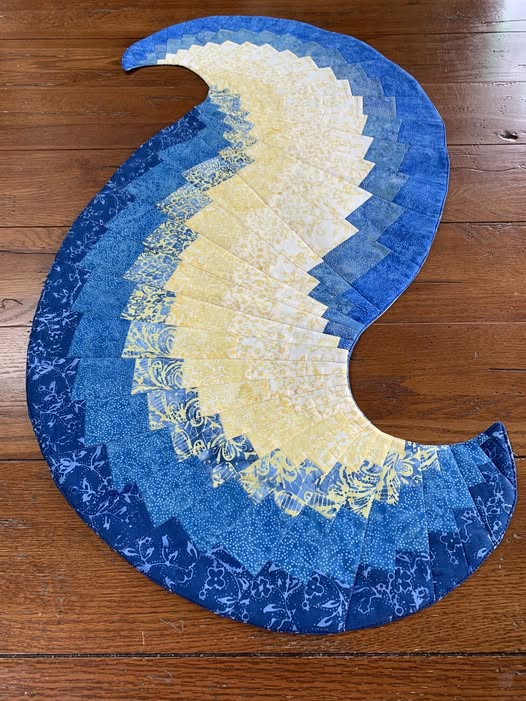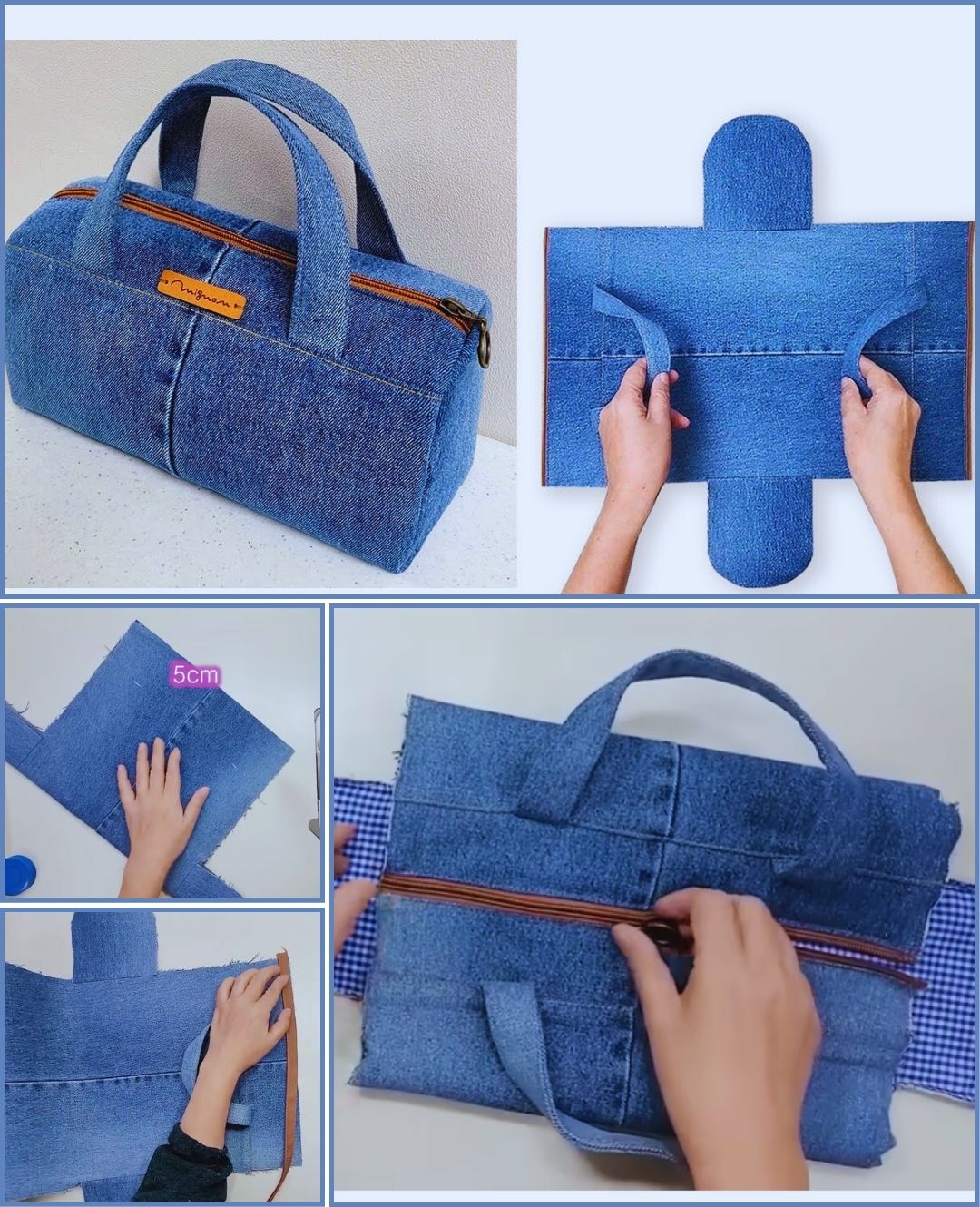
How to Create a Special Zipper Bag Easily Out of Old Jeans is a fun and sustainable way to transform worn-out denim into a stylish, functional accessory.
By following this easy sewing project, you can turn old jeans into a handmade denim bag that’s perfect for storing makeup, stationery, or small travel essentials.
Upcycling old jeans not only reduces waste but also gives your wardrobe and home a creative, personalized touch. This project is beginner-friendly and allows you to create a recycled denim bag with minimal tools and materials.

Using denim for DIY projects is practical because it’s sturdy and durable. Creating a zipper bag DIY from old jeans ensures that your bag can withstand daily use while maintaining its shape.
You can repurpose the pockets, seams, and even the waistband to add interesting design features. The unique textures and washes of denim give each bag a distinctive, one-of-a-kind look. With this method, you’ll be giving your old jeans a second life in a useful and fashionable way.
In this guide, we’ll cover everything from selecting suitable jeans, cutting and preparing fabric, sewing the bag and zipper, and adding finishing touches. You’ll also find tips on customization, like adding embellishments, lining, or repurposed pockets. By following this how to make a zipper bag tutorial, you’ll be able to create a special bag that is not only practical but also reflects your personal style and creativity.
To start your zipper bag DIY, gather a pair of old jeans that you no longer wear. Opt for denim that’s in good condition without too many holes, unless you want a distressed look. You’ll also need a zipper, sewing needle or sewing machine, thread matching the denim color, scissors, pins, chalk or fabric marker, and optionally a lining fabric for added durability.
Reusing pockets and seams from old jeans can add both style and functionality. For instance, you can incorporate the back pocket as an external storage pocket on your recycled denim bag, giving it a unique and practical feature.
The zipper is a key element. A 7–9 inch zipper works for small cosmetic or pencil bags, while longer zippers can accommodate travel or clutch-size bags. Choose a sturdy zipper that will last through repeated use.
Thread selection matters as well. Denim is thick, so using a strong polyester or cotton-wrapped polyester thread ensures durability. Matching the thread color to your jeans creates a professional finish, while a contrasting thread can add a decorative element.
Prepare your workspace before cutting or sewing. A flat surface, good lighting, and organized tools make the process smoother and more enjoyable. Laying out all your materials beforehand will help prevent mistakes and wasted fabric.
Finally, measure and mark your fabric carefully. A clear plan reduces errors during cutting and sewing, ensuring your handmade denim bag turns out neat and proportionate.
Start by selecting the areas of your old jeans you want to use. The legs provide large, continuous fabric pieces ideal for the bag’s body, while pockets and waistbands can be repurposed for design features or closures.
Measure and mark the dimensions of your desired bag. A common size is around 8 inches by 5 inches for a small pouch, but you can adjust based on your needs. Mark the fabric with chalk or a fabric marker to guide your cuts.
Cut the fabric carefully along your markings, ensuring clean, straight edges. Denim frays easily, so precise cutting will make sewing easier and improve the finished bag’s appearance.
If you plan to use a lining, cut fabric pieces to the same dimensions. The lining adds stability, prevents stretching, and provides a smooth interior surface for your zipper bag DIY.
Optional: repurpose pockets from the jeans. Sew them onto the bag’s exterior for extra storage or decorative flair. You can also use seams or jean embellishments like rivets to give the bag a professional, custom look.
Finally, press the fabric pieces with an iron to remove creases and folds. Flattened fabric makes stitching more accurate and ensures that the final recycled denim bag has clean edges and smooth seams.
Begin by positioning the zipper between the fabric pieces, right sides together. Pin it carefully to prevent shifting while sewing. Use a zipper foot on your sewing machine if available for neat, precise stitching.
Sew along one side of the zipper first, then attach the opposite side. Check that the zipper opens and closes smoothly before proceeding. Properly installing the zipper is key for a functional zipper bag DIY.
Once the zipper is secured, fold the fabric with right sides together and pin the sides and bottom of the bag. Sew along the pinned edges, leaving the top open. Reinforce seams at stress points to increase durability.
Optional: topstitch around the zipper to give it a polished look. Topstitching also helps prevent the zipper fabric from curling, ensuring a neat and professional appearance.
If using a lining, sew it separately and insert it into the bag. Sew the lining to the zipper seam for a clean interior finish. A well-stitched lining improves functionality and longevity for your handmade denim bag.
Trim excess threads and fabric edges. Carefully remove pins and press the bag lightly with an iron for crisp, finished edges. Your recycled denim bag is now ready for the final touches.
Adding personal touches makes your zipper bag DIY unique. Consider embroidery, patches, or fabric paint for a decorative flair. Personalized embellishments can reflect your style or make the bag a thoughtful gift.
Repurposing jean pockets on the exterior provides additional storage. Sew the pocket onto the bag front or back, creating a functional and stylish design element.
Handles or straps are another option. You can create a small wrist strap from a denim strip or fabric scrap to make carrying the bag easier. This enhances functionality and turns your recycled denim bag into a versatile accessory.
Adding lining fabric improves durability and prevents items from poking through the denim. Use colorful lining fabric for contrast, or keep it neutral for a classic look.
Optional closures like buttons, snaps, or Velcro can complement the zipper. They provide added security and enhance the design, making your handmade denim bag even more practical.
Finally, press and shape the bag. Smooth edges, reinforced seams, and well-positioned details ensure a polished and professional finish. Your zipper bag DIY is now complete, ready for everyday use or gifting.
Q1: Can beginners make this zipper bag?
A1: Yes! This easy sewing project is beginner-friendly with step-by-step instructions. Basic sewing skills are sufficient.
Q2: What type of jeans works best?
A2: Any durable denim works. Jeans with minimal holes or wear are ideal, though distressed denim can add a trendy, rustic look.
Q3: Do I need a sewing machine?
A3: A sewing machine is recommended for speed and durability, but the bag can be hand-sewn using strong thread and careful stitching.
Q4: How long does it take to make a bag?
A4: Depending on experience, it takes 1–3 hours for a small to medium-size bag.
Q5: Can I add pockets or other features?
A5: Absolutely. Repurposed jean pockets, lining, or straps add style and functionality.
Q6: Is this a good gift idea?
A6: Yes! Handmade recycled denim bags are thoughtful, eco-friendly gifts suitable for birthdays, holidays, or special occasions.
Creating a special zipper bag easily out of old jeans is a rewarding and sustainable project. From selecting old denim and cutting fabric to sewing the zipper and adding finishing touches, this zipper bag DIY is practical, creative, and customizable. Repurposing old jeans into a functional accessory reduces waste and allows you to make a handmade denim bag that reflects your personality.
Try customizing your bag with pockets, embroidery, or contrasting lining to create a truly unique piece. Share your creations, tips, and feedback in the comments—we’d love to see your recycled denim bag projects and hear your thoughts on this fun, eco-friendly sewing tutorial!
